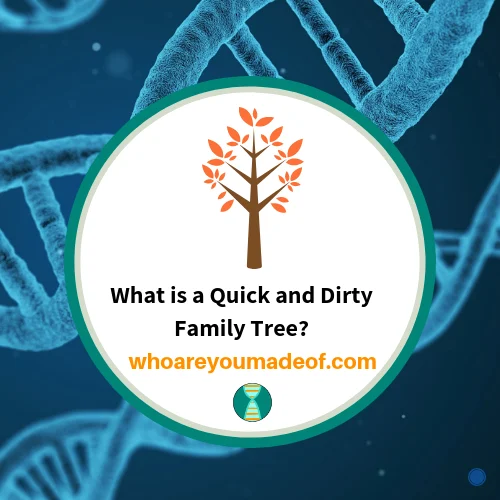In this post, I'll explain to you what a quick and dirty family tree is, and how to use the tree to figure out how your DNA matches are related to you.
Have you heard someone mention a "quick and dirty" family tree? Are you wondering how building a quick and dirty family tree can help you identify your genetic matches, or your DNA matches?

I build quick and dirty family trees all the time. With a little practice, you'll become an expert in putting together these family trees to learn more about your own family history.
What is a quick and dirty family tree?
A quick and dirty family tree is the easiest kind of family tree to build. It's just a basic, bare-bones, "skeleton" tree that typically only has direct ancestors.
We usually don't worry about citing our sources for these trees, and we aren't terribly worried about being 100% accurate when we build them, unless necessity calls for it.
We want to be just accurate enough without sacrificing the point of the tree, which is generally to work back on a particular line of the tree to find a particular ancestor or family.
Being too accurate and focusing on every little detail can make our "quick and dirty trees" just dirty - and not quick. And if they take too long to make, then we wouldn't use them as a strategy for helping build our own family trees.
Basic information contained in a quick and dirty tree might include:
- Names of direct ancestors of the person for whom you are building the tree (in most cases, your DNA match)
- Dates of births for direct ancestors
- Spouses of direct ancestors
- Basic geographic locations of direct ancestors
- If you get stuck on a line (and thus, are risking your tree no longer bearing the name "quick"), it might be helpful to include siblings of direct ancestors - you might be able to find information on a sibling to help you "get back" one generation further on the tree
You might be wondering why in the world you would ever want to build a family tree that was incomplete, possibly contained inaccuracies, and only focus on one particular line of the tree (as opposed to all of them).
If you haven't yet started building a family tree, definitely check out my book which is a guide to family tree building basics.
How a quick and dirty family tree can help you figure out how your DNA match is related
The whole point of building a quick and dirty family tree is not to be creepy, I swear.
There are only two main reasons that I know of to build a quick and dirty tree (please educate me if there are more uses than I mention here ;), and they are 1) to figure out how a DNA match is related to you by finding where their tree intersects with your own and 2) to create a mirror tree.
The main reason that I build quick and dirty trees is to determine how I am related to my DNA matches, so I'll focus on that here.
Are you interested in an example of when it would be helpful to build a quick and dirty tree? I have this DNA match, whose last name I won't mention.
But I was able, with a little hunting and pecking on Google, to find an obituary for this person's grandparents. Actually, I was able to find an obituary for all of their grandparents.
I thought that I matched this person on my dad's German line of the family, based on shared matches.
This is the perfect time to build a quick and dirty tree. I was able to find out a little basic information from online obituaries, and I used this information to create a basic little tree on Ancestry for my mystery DNA match.
I should mention that my match didn't even have a family tree on Family Tree DNA and only had his complete name and home town listed on his profile, so you really can create quick and dirty trees based on almost no information to start with.
Once I entered all of the information that I had on the Ancestry tree, I immediate got hints and was able to use census records and other family trees to quickly add in a couple more generations.
Since I already knew that we didn't match on his Finnish lines, I could ignore those and just search on his German-American side. What was I looking for?
I was looking for our common ancestor, who I did find just a few more generations back.
Once I found out how we were related, I could then add all of those newly discovered lines of my family into my main "real" tree, and then delete the quick and dirty tree.
Where do you get enough information to build a quick and dirty tree?
Now you know what this type of tree is, and why to build one, but your next question is probably going to be about how to find out enough basic information to get started building a tree like this for your match.
You might not be able to build a quick and dirty tree for every single person on your DNA match list, especially for people who have no tree and are only listed by their initials. Even so, you really don't need much to work with to get started with a tree.
Even if your DNA match only has a tree with a couple of people in it, you should be able to use this information to find obituaries or other types of records to get started with your quick and dirty tree.
Make sure to check your DNA match's profile to see if they list their location, and do a search to see if they have posted a small family tree somewhere else online.
As I mentioned before, obituaries online can be an excellent source of information for building family trees (even non-quick and dirty ones), so make sure to take advantage of the information you can find on search engines.
A quick and dirty tree should always be private and non-searchable
Even though quick and dirty trees are very helpful to the person who is building them, their very nature should make us want to ensure that no one ever actually sees them. There are several reasons for this.
Quick and dirty family trees should be private because:
- When we build them, we generally aren't focused on citing sources, accuracy (such as exact birth dates, etc), or adding every living family member for each generation. If we allow people to view these trees and possibly (gasp!) use them as sources for their own family tree, we might be contributing to the spread of misinformation online - and we all know that the internet has more than its fair of misinformation.
- Occasionally, your DNA match might stumble upon your quick and dirty tree while it is still in progress. Talk about awkward! Um... why do you have my dad in your four-person family tree? Is there something I should know?
- We want to protect the privacy of the immediate family members of our DNA matches, and by keeping the names of their most recent ancestors private, we can help do that.
If you want to be sure that no one ever sees a quick and dirty tree, you can do what I sometimes do. Build it on a scratch piece of paper and then throw it away once you are done.
I know that most people build these types of trees on Ancestry or another such site for easily making family trees, but we shouldn't forget that going old-school is an excellent way of staying private when it counts most.
And finally, once you are done with the tree, especially if you built it online, it's best to delete it. No use taking up server space if you are never going to use that tree again.
Conclusion
I hope that this post has given you an idea as to what a quick and dirty family tree is, how to build one, and how it can help you determine how someone is related to you.
If you have any questions about something that you read in this post, or if you would like to share your own tips on building quick and dirty trees, I would love to hear from you in the discussion below.
Thanks for stopping by!


Claire
Sunday 5th of December 2021
I came upon your blog just after I had just done the same thing! Well, I came up with it myself! I'm trying to find out the identity of my great, great grandfather. This person is my closest match and I have no idea how we are related. I'm still getting nowhere with that dirty tree but seeing that this is a 3rd cousin we must match somewhere. I believe my match may hold the key,
DNA Comes Through In A Big Way, Part II – Bubba’s Branches
Sunday 30th of August 2020
[…] that I have finally had a little time to set everything up and connect my quick and dirty tree for my father-in-law to his DNA test, I can not only see his matches but I can also see his […]
Clay L Price
Sunday 9th of August 2020
Mercedes, here's another example where a quick & dirty tree proved useful. I have a stamp from my boyhood collecting days that is attached to a check that was signed on Oct 16, 1899 with the National Bank of Cleburne Texas. The stamp is a tax stamp that was required for checks in those days. It's a very cool addition to the collection. Recently I started wondering about the man who signed the check and the man who cashed it. I realized I now possess the skills from my ancestry research to learn about these two men. I created quick and dirty trees for both of them. The signer turned out to be the superintendent of the Cleburne schools--Census data and newspaper articles gave me his life story. The person who received the $50 check was one of three men who ran the "new" Hamilton Hotel in town. The man had been born in Prussia and came to America when he was 15. He gained experience in general merchandising and then the hotel business in Georgia. The Hamilton Hotel had a "sample room" where salesmen could display and sell their wares. Most likely the superintendent bought something from the sample room, paying with that check. Both men died a few years later. Their stories (much more than what I've mentioned) remembered because of a check with a tax stamp that exchanged hands in 1899 and ended up in a boy’s stamp collection in the 1950s and a quick and dirty family tree created by the senior adult who still has that collection!
Mercedes
Monday 10th of August 2020
Hi Clay, Thank you SO much for this comment. Yes, these quick and dirty trees are quite helpful. I love the story that you shared and I am glad that you were able to use the skills that you have acquired in order to dig up a very interesting bit of history. Have a wonderful day and best of luck in your genealogy search, Mercedes